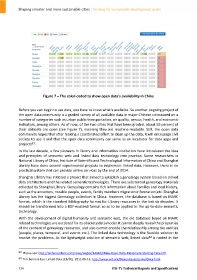Page 734 - Shaping smarter and more sustainable cities - Striving for sustainable development goals
P. 734
Figure 7 – The color‐coded to show open data's availability in China
Before you can begin to use data, you have to know what's available. So another ongoing project of
the open data community is a graded survey of all available data in major Chinese citiesbased on a
number of categories such as urban public transportation, air quality, census, health, and economic
indicators, among others. As of now, of the two cities that have been graded, about 50 percent of
their datasets are open (see Figure 7), meaning they are machine‐readable. Still, the open data
community hopes that after making a coordinated effort to clean up the data, it will encourage civil
society to use it and that the open data community can serve as an incubator for data apps and
63
projects .
In the last decade, a few pioneers in library and information institution have introduced the idea
and principles of semantic web and linked data technology into practice. Some researchers in
National Library of China, Institute of Scientific and Technological Information of China and Shanghai
Library have done several experimental projects to implement linked data. However, there is no
practical system that can provide online services by the end of 2014.
Shanghai Library has initiated a project that aimed to establish a genealogy system based on Linked
data architecture and the related semantic technologies. There are substantial genealogy materials
collected by Shanghai Library. Genealogy contains rich information about families and local history,
such as the ancestors, notable people, events, family members migration information,etc. Shanghai
Library has the biggest Genealogy collection in China. However, the database is based on MARC
format, which is the standard bibliography format for Library resources in the last six decades. It
should be transformed into a RDF‐enabled format so as to be applied to the up‐to‐date semantic
technology.
With the development of digital humanity and semantic web, the old database based on MARC
related technologies are outdated for its obsolete data model. It cannot deeply reveal the properties
of the content of genealogy resources, and also cannot encode the relationship among the entities
(people, places, temporal, and events etc.). The linked data technology is the feasible solution to
resolve the problems. As the lightweight solution of semantic web, linked data is rooted in the
64
____________________
63 Please see: http://techpresident.com/news/wegov/24940/China‐Open‐Data‐Movement‐Starting‐Take‐Off.
64 Tim Berners‐Lee. Linked Data [EB/OL]. 2011‐05‐15. http://www.w3.org/DesignIssues/LinkedData.html.
724 ITU‐T's Technical Reports and Specifications

